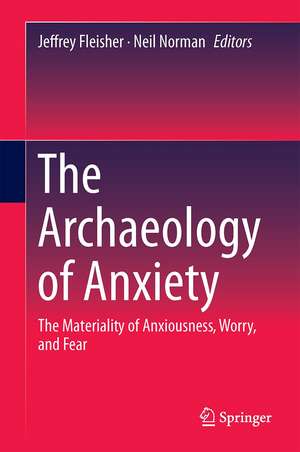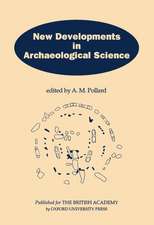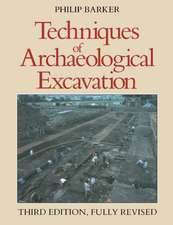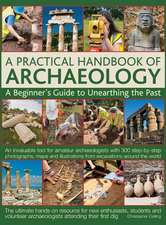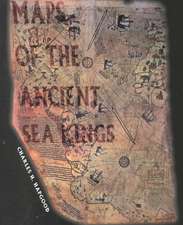The Archaeology of Anxiety: The Materiality of Anxiousness, Worry, and Fear
Editat de Jeffrey Fleisher, Neil Normanen Limba Engleză Hardback – 17 dec 2015
Yet research on emotion in archaeology remains limited, despite the fact that such states underpin many studies of socio-cultural transformation. The Archaeology of Anxiety draws together papers that examine the local complexities of anxiety as well as the variable stimuli—class or factional struggle, warfare, community construction and maintenance, personal turmoil, and responsibilities to (and relationships with) the dead—that may generate emotional responses of fear, anxiousness, worry, and concern.
The goal of this timely volume is to present fresh research that addresses the material dimension of rites and performances related to the mitigation and negotiation of anxiety as well as the role of material culture and landscapes in constituting and even creating periods or episodes of anxiety.
| Toate formatele și edițiile | Preț | Express |
|---|---|---|
| Paperback (1) | 637.13 lei 6-8 săpt. | |
| Springer – 27 mar 2019 | 637.13 lei 6-8 săpt. | |
| Hardback (1) | 643.34 lei 6-8 săpt. | |
| Springer – 17 dec 2015 | 643.34 lei 6-8 săpt. |
Preț: 643.34 lei
Preț vechi: 756.86 lei
-15% Nou
Puncte Express: 965
Preț estimativ în valută:
123.12€ • 127.19$ • 102.47£
123.12€ • 127.19$ • 102.47£
Carte tipărită la comandă
Livrare economică 25 martie-08 aprilie
Preluare comenzi: 021 569.72.76
Specificații
ISBN-13: 9781493932306
ISBN-10: 1493932306
Pagini: 330
Ilustrații: IX, 215 p. 38 illus., 9 illus. in color.
Dimensiuni: 155 x 235 x 14 mm
Greutate: 0.5 kg
Ediția:1st ed. 2016
Editura: Springer
Colecția Springer
Locul publicării:New York, NY, United States
ISBN-10: 1493932306
Pagini: 330
Ilustrații: IX, 215 p. 38 illus., 9 illus. in color.
Dimensiuni: 155 x 235 x 14 mm
Greutate: 0.5 kg
Ediția:1st ed. 2016
Editura: Springer
Colecția Springer
Locul publicării:New York, NY, United States
Public țintă
ResearchCuprins
Chapter 1: Archaeologies of Anxiety: The Materiality of Anxiousness, Worry, and Fear Jeffrey Fleisher and Neil Norman.- Chapter 2:
The Importance of “Getting It Right:” Tracing Anxiety in Mesolithic Burial Rituals Liv Nilsson Stutz.- Chapter 3: Risky Business: A Life Full of Obligations to the Dead and the Living on the Early Bronze Age Southeastern Dead Sea Plain, Jordan Meredith Chesson.-Chapter 4: Feet of Clay: An Archaeology of Huedan Elite Anxiety in the era of Atlantic Trade Neil Norman.- Chapter 5: Hid in Death’s Dateless Night: The lure of an uncanny landscape in Hittite Anatolia
Tim Flohr Sørensen and Stephen Lumsden.- Chapter 6: Communities of Anxiety: Gathering and Dwelling at Causewayed Enclosures in the British Neolithic Oliver Harris.- Chapter 7:
Bodily Protection: Dress, Health, and Anxiety in Colonial New England Diana DiPaolo Loren.- Chapter 8: Ritualized Coping during War: Conflict, Congregation, and Emotions at the Late Prehispanic Fortress of Acaray Margaret Brown Vega.- Chapter 9: “Concern”ing contributions to this volume Susan Kus.
The Importance of “Getting It Right:” Tracing Anxiety in Mesolithic Burial Rituals Liv Nilsson Stutz.- Chapter 3: Risky Business: A Life Full of Obligations to the Dead and the Living on the Early Bronze Age Southeastern Dead Sea Plain, Jordan Meredith Chesson.-Chapter 4: Feet of Clay: An Archaeology of Huedan Elite Anxiety in the era of Atlantic Trade Neil Norman.- Chapter 5: Hid in Death’s Dateless Night: The lure of an uncanny landscape in Hittite Anatolia
Tim Flohr Sørensen and Stephen Lumsden.- Chapter 6: Communities of Anxiety: Gathering and Dwelling at Causewayed Enclosures in the British Neolithic Oliver Harris.- Chapter 7:
Bodily Protection: Dress, Health, and Anxiety in Colonial New England Diana DiPaolo Loren.- Chapter 8: Ritualized Coping during War: Conflict, Congregation, and Emotions at the Late Prehispanic Fortress of Acaray Margaret Brown Vega.- Chapter 9: “Concern”ing contributions to this volume Susan Kus.
Recenzii
“This volume is a bold, forward thinking, and essential contribution to this movement in archaeology. … The writing of this volume contains a tone of defending the choice to study emotion as a way to advocate for its more widespread acceptance in the discipline. The results of the volume should certainly compel more archaeologists to embrace this way of thinking about the past, and recognize the potential to more fully study people’s lives through the archaeological record.” (Jane Eva Baxter, Journal of Eastern Mediterranean Archaeology and Heritage Studies, Vol. 6 (1–2), 2018)
Notă biografică
Jeffrey Fleisher (BA, MA, PhD, University of Virginia) is an Associate Professor in the Department of Anthropology at Rice University in Houston, Texas. His regional specialty is on the ancient Swahili coast of eastern Africa, focusing on the development of first and second millennium urban centers there. Past research has focused on the ancient settlements of rural and non-elite Swahili, and their connections and contributions to urban developments. Currently, he directs a long-term project at the UNESCO World Heritage Site of Songo Mnara in southern Tanzania, focusing on the use of open and public space.
Neil Norman (BA, Flagler College; MA, University of South Carolina; PhD, University of Virginia) is an Associate Professor in the Department of Anthropology at the College of William and Mary in Williamsburg, VA. His specialties are the archaeology of social complexity and historical archaeology. At present, hedirects the Savi Countryside Archaeological Project (Republic of Benin), the Africatown Archaeological Project (Mobile, Alabama) and co-directs the Later Zanzibar Archaeological Project (Republic of Tanzania).
Neil Norman (BA, Flagler College; MA, University of South Carolina; PhD, University of Virginia) is an Associate Professor in the Department of Anthropology at the College of William and Mary in Williamsburg, VA. His specialties are the archaeology of social complexity and historical archaeology. At present, hedirects the Savi Countryside Archaeological Project (Republic of Benin), the Africatown Archaeological Project (Mobile, Alabama) and co-directs the Later Zanzibar Archaeological Project (Republic of Tanzania).
Textul de pe ultima copertă
Recent efforts to engage more explicitly with the interpretation of emotions in archaeology have sought new approaches and terminology to encourage archaeologists to take emotions seriously. This is part of a growing awareness of the importance of senses—what we see, smell, hear, and feel—in the constitution and reconstitution of past social and cultural lives.
Yet research on emotion in archaeology remains limited, despite the fact that such states underpin many studies of socio-cultural transformation. The Archaeology of Anxiety draws together papers that examine the local complexities of anxiety as well as the variable stimuli—class or factional struggle, warfare, community construction and maintenance, personal turmoil, and responsibilities to (and relationships with) the dead—that may generate emotional responses of fear, anxiousness, worry, and concern.
The goal of this timely volume is to present fresh research that addresses the material dimension of rites and performances related to the mitigation and negotiation of anxiety as well as the role of material culture and landscapes in constituting and even creating periods or episodes of anxiety.
Yet research on emotion in archaeology remains limited, despite the fact that such states underpin many studies of socio-cultural transformation. The Archaeology of Anxiety draws together papers that examine the local complexities of anxiety as well as the variable stimuli—class or factional struggle, warfare, community construction and maintenance, personal turmoil, and responsibilities to (and relationships with) the dead—that may generate emotional responses of fear, anxiousness, worry, and concern.
The goal of this timely volume is to present fresh research that addresses the material dimension of rites and performances related to the mitigation and negotiation of anxiety as well as the role of material culture and landscapes in constituting and even creating periods or episodes of anxiety.
Caracteristici
Discusses the nature/culture divide in emotions research Offers an archaeological contribution to the burgeoning field of emotions research Examines archaeological evidence for both the causes and effects of anxiety
